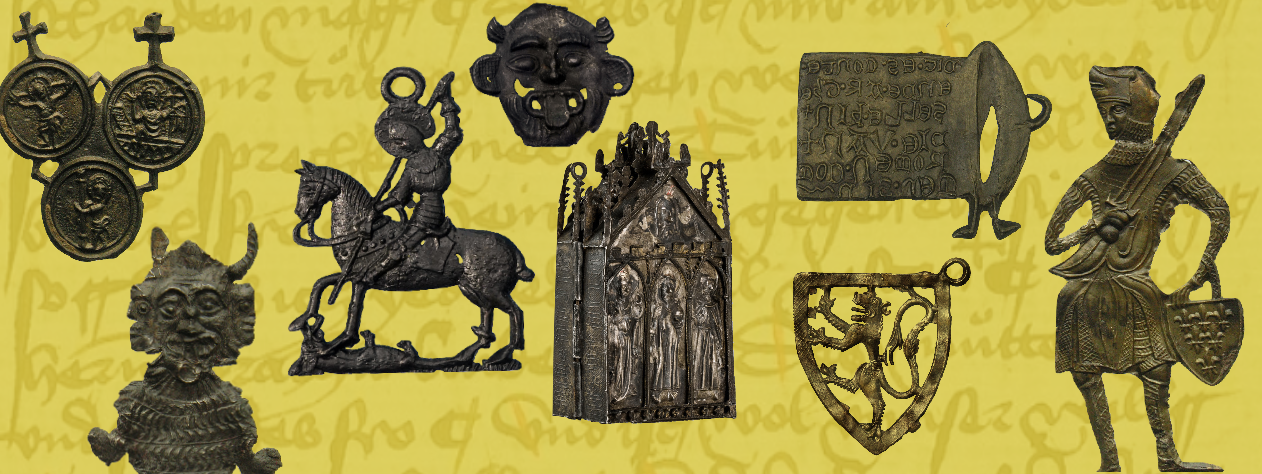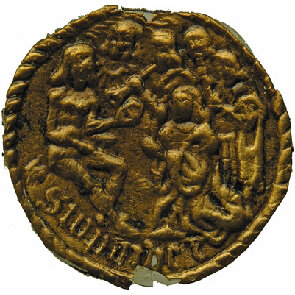Over the past several months, Kendall Diemer has developed familiarity with the historical and material aspects of the medieval past in order to curate two exhibitions based on the collection of medieval objects housed at the University of Waterloo’s Medieval Digital Research in Arts and Graphical Environmental Networks Laboratory (DRAGEN Lab). We are happy to announce the start of Kendall’s second exhibition, which explores the collection through the lens of decay. The exhibition will take place from Monday, March 13th to Monday, April 3rd at St. Jerome’s University (SJ1, second floor). This blog post serves as an introduction to the inspiration behind the exhibition and to Kendall’s views on the topic.
Musings on Decay
There are many things that run through one’s mind when walking through a museum and looking carefully at the intentionally curated objects on display: awe, interest, questions about the objects’ purposes, or about who used the object. Perhaps one’s thoughts turn to how amazing it is to be able to view these objects at all; how fortunate we are that not only did these objects survive for long periods of time, but that they were discovered and now arranged in museums that allow us to engage with the objects and to learn about the past. When we look at these survived objects, they may appear to be old, ancient, worn down, or showing signs of damage, but how often, as a museum visitor, do we take conscious note of this? Do we see a medieval manuscript as old based on how long it has existed or as old in terms of its physical appearance, its signs of decay? How often, if at all, are the thoughts that we have towards museum objects centered on decay?
Dictionaries define decay as:
“The gradual decline in strength, soundness, or prosperity, or in degree of excellence or perfection; to decline in health, strength, vigor; to fall into ruin; to undergo decomposition.” (Merriam-Webster, 2023)
“Slowly fall apart and become destroyed by natural processes, a slow change from a state of strength or perfection.” (Britannica, 2023)
“The process or result of being destroyed by natural causes or by not being cared for.” (Oxford Learner’s Dictionary, 2023)
Objects in museums are often revered for having existed for hundreds or thousands of years. We tend to have this subconscious idea that they will continue to exist for thousands more.[1] Because of this, decay is not always front of mind. And yet despite this sense of permanence associated with the museum object, all objects within a collection are subject to decay. In the collection of objects I study at the DRAGEN Lab, for instance, there are books with damaged spines, the pages of which have become stiff and yellowed, and manuscripts that have been damaged by insects, water and even tape. Objects are decaying and showing signs of it. The preservation and conservation of objects in museum contexts is what allows us to view them without actively noticing every sign of decay.
An incunabula leaf from the Postilla Super Psalterium, a commentary on the Psalms written by Cardinal Hugh, of Saint-Cher ca. 1200-1263. Printed on 31 January 1498 in Nuremberg by Anton Koburger. Folio leaf measures 322 x 220 mm and contains 72 lines of unadorned Latin gothic script in double columns and contains commentary on Pslams 35 and 36. Note damage due to tape.
Decay is negative: it destroys; it must be prevented, and objects restored. Decay is also a natural process: it is authentic to the lifecycle of the object; it is a “testimony to the passage of time”.[2] While there is a prevalent notion of decaying objects as items to be dismissed, rejected or even feared—think of those objects that have been exposed to mice, insects, moulds and other harbourers of disease—there are instances where decay can also be desirable or expected. Consider ruins which, by their name, are expected to be ruined to some extent. Or how about medieval manuscripts, such as those in the collections of the DRAGEN Lab? Seeing the yellowing pages, torn edges, and faded script adds a level of intrigue. At times, and for certain objects, decay provides value in its provocation of feelings of reverence or wonder towards the past. It may even prove to serve as a greater connection to the generations of the past when we can see how the object is worn down from use by people who lived long before us.[3]
Top: M6406 Choirbook in Latin Manuscript on parchment. France c.1500. Middle: Concordantiae Bibliorum Sacrorum Emendatae, Vulgatae Editionis. Bottom: Volvmen.
The next time you visit a museum, or come across a heritage site or historical object, keep decay in mind. When considering an object’s signs or level of decay, think about your interpretations of the decay. Do you have a negative association to the concept? Does the decay add value to the object or does it make you want to dismiss it, or perhaps see it fixed and restored? Can these conflicting interpretations of decay be resolved? Where is the line in decay being fascinating or repulsive, good or bad, repairable and of value, or unworthy and to be disposed?
Personally, I feel that the focus on the negative connotations of decay needs to be done away with. Decayed and decaying objects can still provide value whether historically, aesthetically or even philosophically. Decay serves as a reminder that even these objects of reverence are subject to the same processes that we are; that a decline in excellence and perfection is natural; that though things cannot be preserved completely it does not mean they lose their value.
____________________
[1] Jill Saunders. “Conservation in Museums and Inclusion of the Non-Professional.” Journal of Conservation and Museum Studies, 12(1): 6, pp.1-13.
[2] Rachel Douglas-Jones, John J. Hughes, Sian Jones, Thomas Yarrow. “Science, value and material decay in the conservation of historic environments.” Journal of Cultural Heritage, 21 (2016): 823-833
[3] Rachel Douglas-Jones et al. “Science, value and material decay in the conservation of historic environments.”
Works Cited
DeSilvey, Caitlin. “Observed Decay: Telling Stories with Mutable Things.” Journal of Material Culture,1, no.3 (2016): 318-338. https://doi.org/10.1177/1359183506068808
Douglas-Jones, Rachel, Hughes, John J., Jones, Sian, Yarrow, Thomas. “Science, value and material decay in the conservation of historic environments.” Journal of Cultural Heritage, 21 (2016): 823-833. https://www.sciencedirect.com/science/article/pii/S1296207416300346
Saunders, Jill. “Conservation in Museums and Inclusion of the Non-Professional.” Journal of Conservation and Museum Studies, 12(1): 6, pp. 1-13, DOI: http://dx.doi.org/10.5334/jcms.1021215
Kendall Diemer is an emerging museum professional and interdisciplinary student. She is currently pursuing a Bachelor of Arts in Liberal Studies with a minor in Medieval Studies at the University of Waterloo. She previously completed her Bachelor of Science in Biological Sciences with a minor in Philosophy at the University of Windsor. She has been a member of the DRAGEN Lab since 2021.
The project-based independent study course that facilitated these exhibitions was led by Dr. Ann Marie Rasmussen and supported by the DRAGEN Lab.
Written by Kendall Diemer. Edited by Hannah Gardiner.































